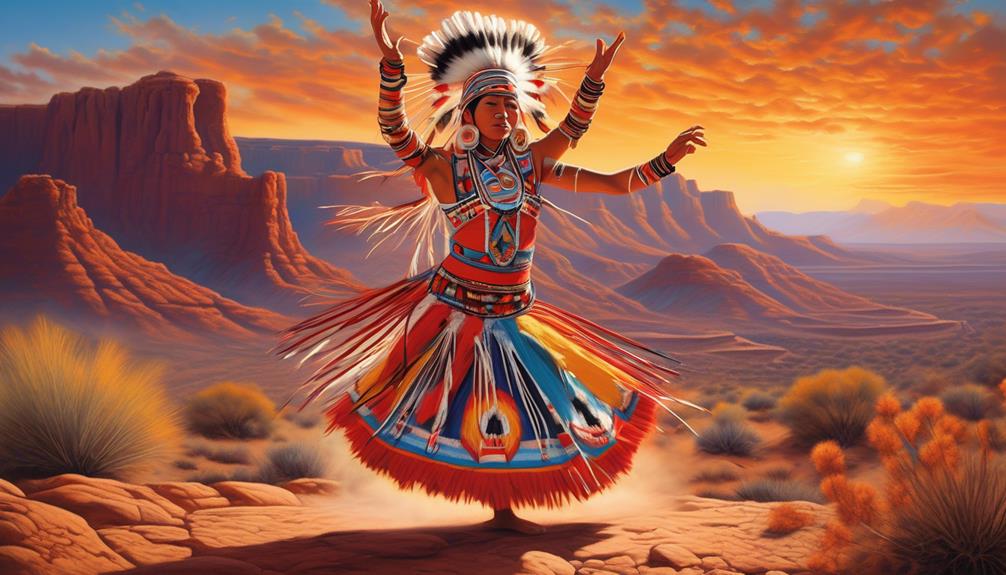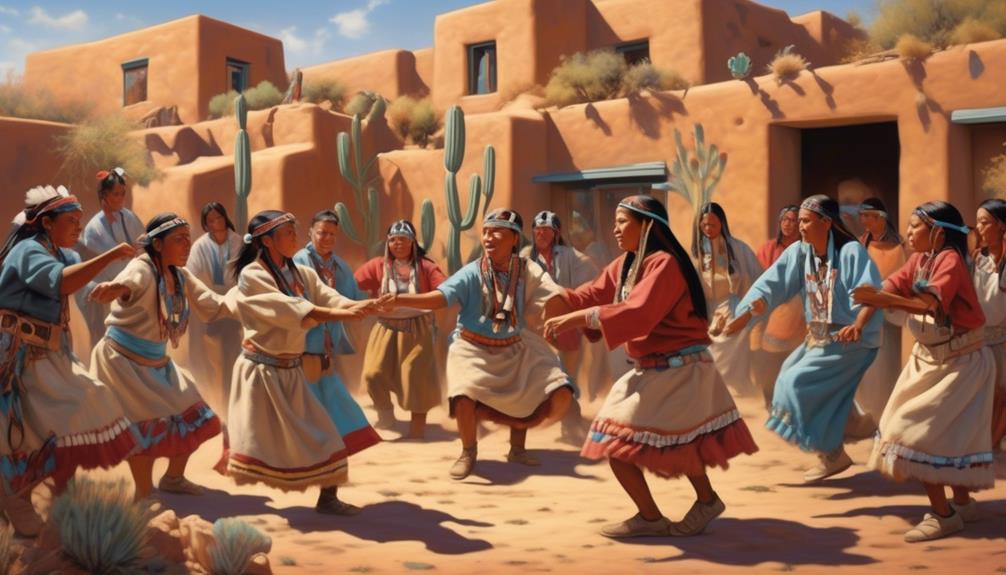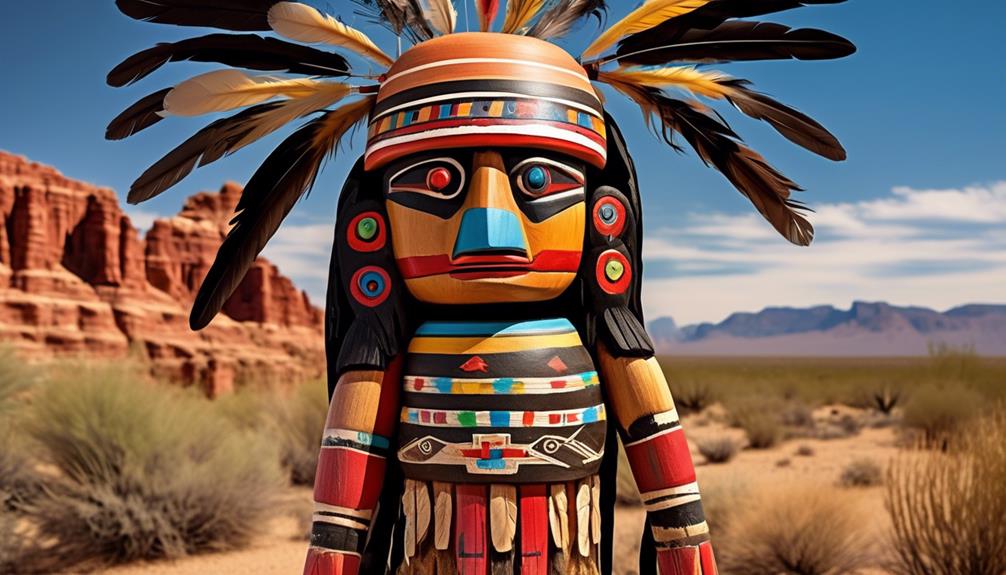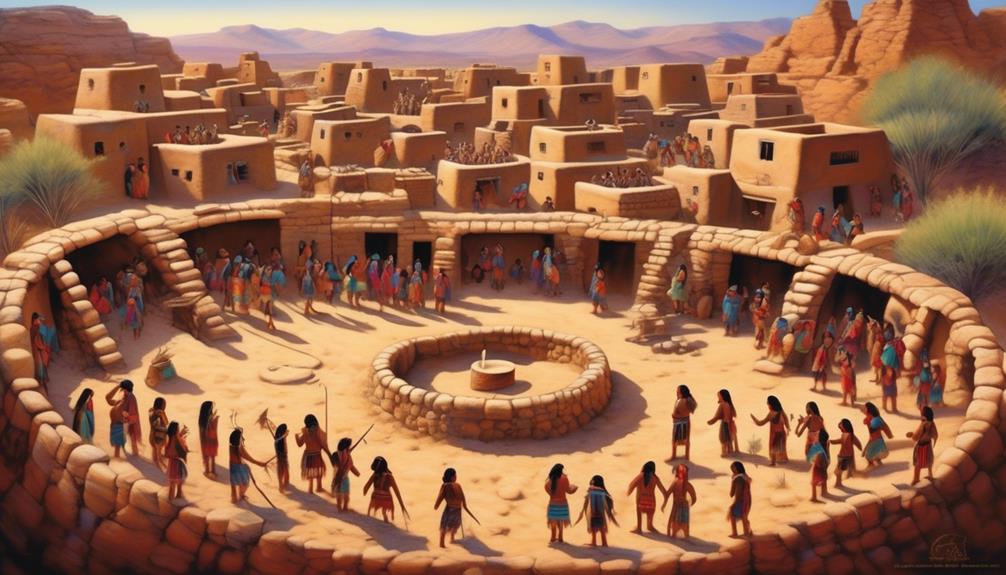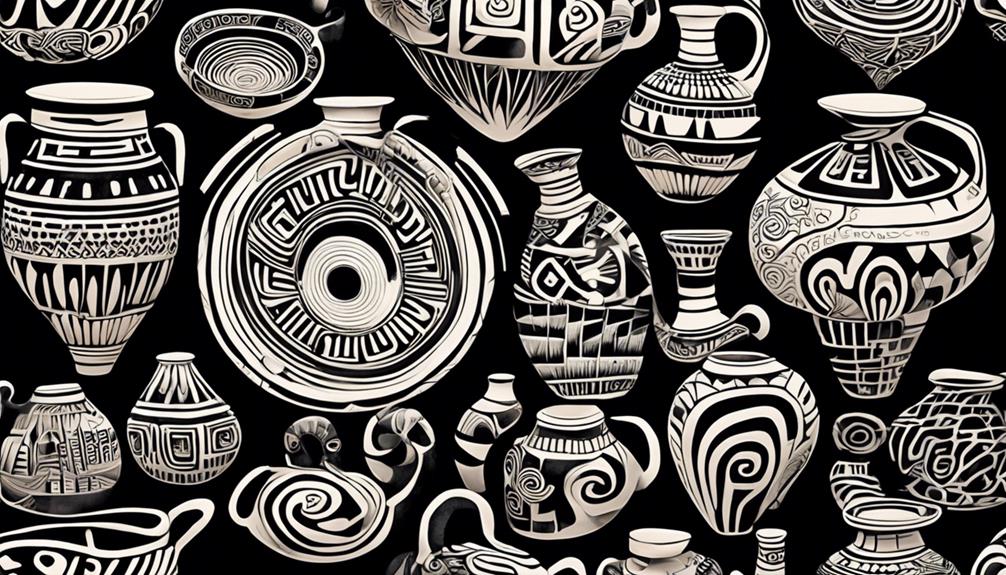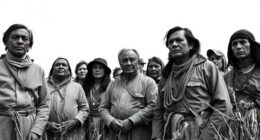When examining the various Indigenous tribes, the Hopi tribe stands out like a valuable gem. Their unique spiritual beliefs, intricate artistic works, traditional rituals, agricultural and environmental methods, and distinct social organization set them apart from other tribes.
But what exactly makes the Hopi tribe different from all the others? Let's explore the fascinating intricacies that distinguish the Hopi people and their way of life.
Key Takeaways
- Hopi spiritual beliefs and practices emphasize a profound connection to the land and a responsibility to preserve it.
- Hopi artistic expressions, such as pottery and dances, depict a deep connection to the natural world and preserve the tribe's cultural heritage.
- Hopi traditional ceremonial practices, including sacred rituals and dances, serve as prayers and foster a sense of community and belonging.
- Hopi agricultural and environmental practices, such as dry farming and seed preservation, reflect the tribe's commitment to nature and ancestral wisdom.
Unique Spiritual Beliefs
The Hopi Tribe's unique spiritual beliefs are deeply rooted in their cultural heritage and continue to shape their way of life. Spiritual ceremonies play a central role in the Hopi people's lives, serving as a means of connecting with their ancestors and the divine. These ceremonies are elaborate, often lasting several days and involving intricate rituals that have been passed down through generations. The ritual symbolism within these ceremonies reflects the Hopi's reverence for the earth, the elements, and the cycle of life.
Through dances, songs, and prayers, the tribe seeks to maintain harmony and balance in the world, serving not only their own community but all of humanity.
Comparatively, the spiritual beliefs of the Hopi Tribe are distinct from those of other Native American tribes, emphasizing a profound connection to the land and a responsibility to preserve it for future generations. This sense of stewardship is evident in their rituals, which are designed to honor and protect the natural world.
Intricate Artistic Expressions
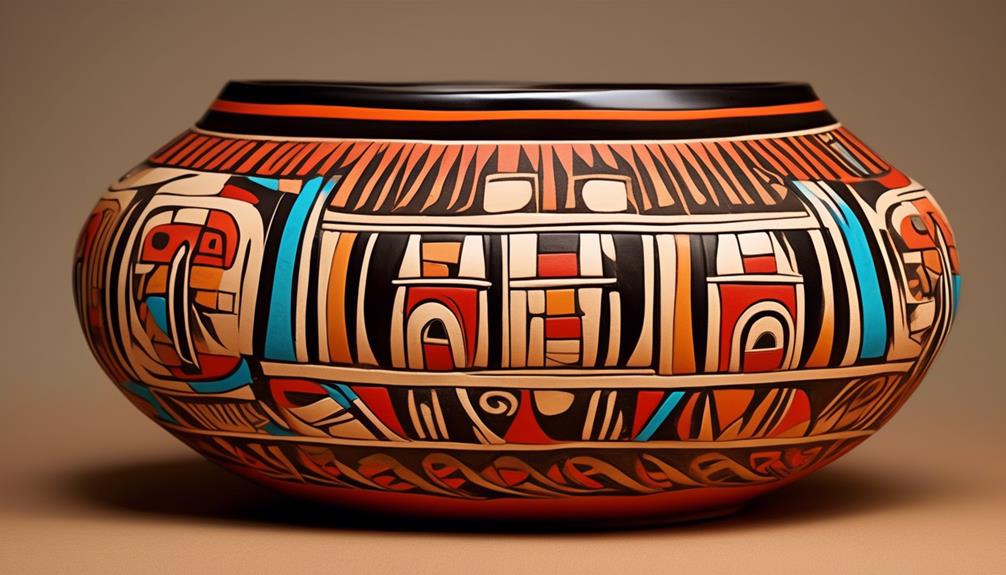
Elegantly weaving together symbols of their heritage, the Hopi Tribe's artistic expressions reflect a profound connection to their cultural traditions and the natural world. The intricate artistic expressions of the Hopi Tribe are a testament to their rich cultural heritage and spiritual beliefs.
Here are some key elements that set their artistic expressions apart:
- Symbolic Pottery: The Hopi Tribe is renowned for their intricate and symbolic pottery, which often features elaborate designs representing elements of their mythology, daily life, and spiritual beliefs.
- Intricate Dances: The Hopi people are known for their elaborate and sacred dances, which are integral to their ceremonial practices. These dances are performed with precision and grace, conveying stories and spiritual teachings through movement and music.
- Connection to Nature: The artistic expressions of the Hopi Tribe often depict their deep connection to the natural world, with motifs inspired by the landscapes, flora, and fauna of their ancestral lands.
- Cultural Continuity: Through their artistic expressions, the Hopi Tribe has maintained a remarkable continuity of their cultural traditions, preserving their unique artistic styles and techniques for generations.
The Hopi Tribe's artistic expressions serve as a powerful means of preserving and conveying their cultural heritage, enriching not only their own community but also sharing their traditions with the world.
Traditional Ceremonial Practices
With deep reverence for ancestral wisdom and spiritual connections, the Hopi Tribe enacts traditional ceremonial practices that embody their cultural identity and historical legacy. Sacred rituals play a central role in the Hopi way of life, serving as a means of connecting with their ancestors, the natural world, and the divine. These rituals are deeply rooted in the tribe's history and are essential for maintaining the balance and harmony of the world.
The Hopi people believe that through the performance of these sacred ceremonies, they contribute to the well-being of not only their own community, but the entire world.
Ceremonial dances are a significant aspect of the Hopi traditional practices, each holding its own unique symbolism and purpose. These dances often depict stories of creation, migration, and the teachings of their ancestors. Through intricate movements and powerful rhythms, the dancers convey messages of spiritual significance, passing down ancient knowledge from one generation to the next.
These ceremonial dances serve as a form of prayer, connecting the Hopi people to their spiritual beliefs and fostering a deep sense of community and belonging.
Agricultural and Environmental Practices
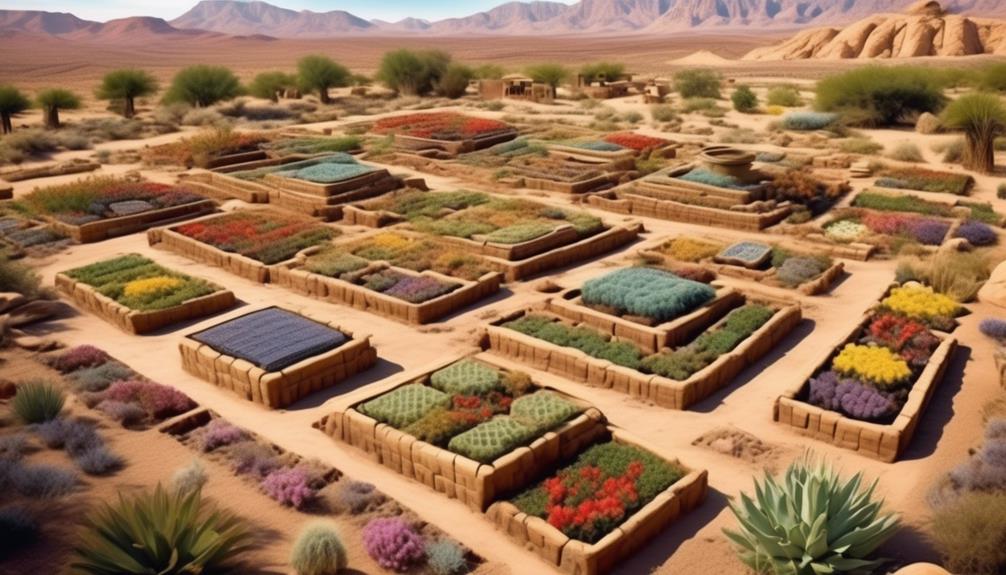
Engaging in agricultural and environmental practices, we honor the interconnectedness of our traditions with the natural world, perpetuating the wisdom passed down by our ancestors. Our sustainable farming methods and conservation techniques are deeply rooted in our cultural heritage, setting us apart from other tribes.
Here are some key aspects of our agricultural and environmental practices:
- Dry Farming: We've mastered the art of dry farming, utilizing ancient techniques that conserve water and promote soil health. By cultivating crops such as corn, beans, and squash without irrigation, we demonstrate our commitment to sustainable agriculture.
- Terracing: Our ancestors constructed intricate terraces on the mesas, allowing us to cultivate crops in the arid desert landscape. These terraces not only maximize the use of limited arable land but also prevent soil erosion, showcasing our innovative conservation methods.
- Seed Preservation: We prioritize the preservation of heirloom seeds, safeguarding the genetic diversity of our traditional crops. This practice ensures the resilience of our agricultural heritage in the face of environmental challenges.
- Water Management: Through sophisticated water management techniques, including the construction of qanats and cisterns, we efficiently harness and distribute water for agricultural purposes, embodying our commitment to environmental stewardship.
Our agricultural and environmental practices reflect our deep reverence for nature and the wisdom of our forebears, underscoring the unique character of the Hopi Tribe.
Distinctive Social Organization
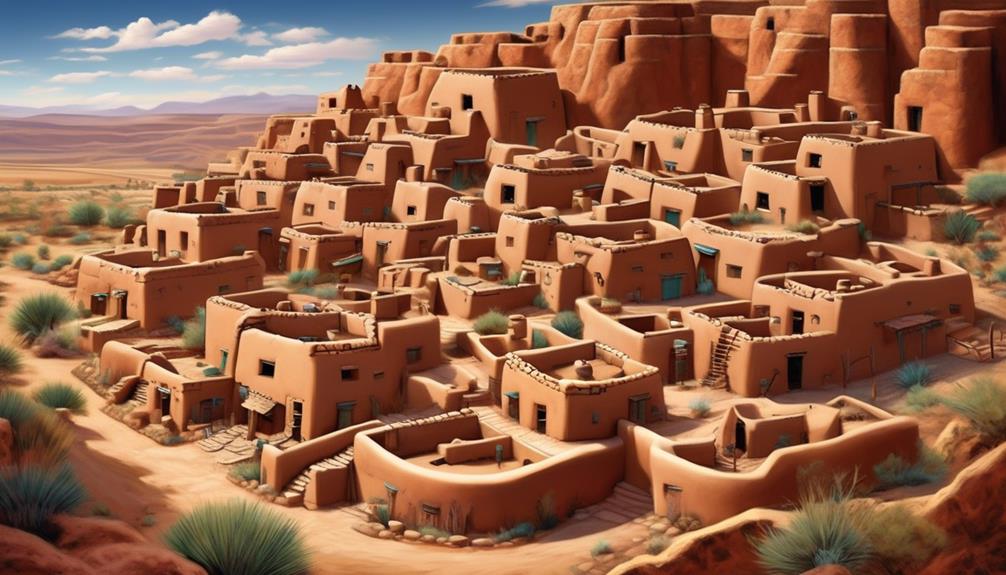
In our rich cultural tapestry, the distinctive social organization of the Hopi Tribe is a testament to our enduring traditions and communal bonds. Our kinship structure forms the foundation of our society, emphasizing strong family ties and a deep sense of interconnectedness. This is reflected in our leadership roles, where wisdom and experience are highly valued. The Hopi Tribe's social organization is characterized by a unique balance of autonomy and collective responsibility, with each member playing a vital role in the community.
| Kinship Structure | Leadership Roles |
|---|---|
| Matrilineal descent | Kikmongwi (village chief) |
| Clan-based relationships | Powamu priests |
| Emphasis on extended family | Kachina society leaders |
Our kinship structure, based on matrilineal descent and clan-based relationships, fosters a deep sense of belonging and mutual support. Leadership roles within the tribe, such as the Kikmongwi (village chief), Powamu priests, and Kachina society leaders, are entrusted with upholding our traditions and guiding the community. This distinctive social organization not only shapes our daily interactions but also serves as a source of strength and resilience for the Hopi Tribe.
Frequently Asked Questions
How Does the Hopi Tribe View Their Role in Preserving the Environment and Practicing Sustainable Agriculture?
In our tribe, preserving traditions is at the heart of our role in environmental stewardship and sustainable agriculture. We believe in honoring the land and our ancestors by practicing sustainable farming methods that have been passed down for generations.
Our cultural preservation efforts are deeply tied to our agricultural practices, as we work to maintain our connection to the land and uphold our responsibility to care for it as our ancestors did.
What Are Some Unique Artistic Symbols and Motifs That Are Commonly Found in Hopi Artwork?
Hopi artistic symbols and motifs hold deep cultural significance, influencing our art for generations. These symbols often reflect our connection to nature, spirituality, and our ancestral heritage.
The kachina, a central figure in Hopi art, represents our belief in the spirit world. Other common motifs include the migration pattern of our ancestors and the life-giving sun.
Each symbol tells a story, preserving our traditions and honoring our unique identity.
How Do Traditional Hopi Ceremonies Differ From Those of Other Native American Tribes?
Traditional Hopi ceremonies are unique in their emphasis on maintaining balance and harmony with nature, community, and the spiritual world. Our ceremonial practices, while sharing similarities with other Native American tribes, set us apart in our cultural significance and ceremonial rituals.
Our ceremonies are deeply rooted in our history and are essential for ensuring the well-being of our community. These differences reflect the Hopi Tribe's commitment to preserving our cultural heritage and spiritual identity.
What Specific Social Customs or Traditions Set the Hopi Tribe Apart From Other Tribes?
Hopi social customs and unique traditions are deeply rooted in sustainable agriculture and environmental preservation. Our tribe's intimate connection to the land shapes our way of life, setting us apart from other tribes.
Through our ceremonial practices, we honor and sustain the earth, ensuring its abundance for future generations. These customs reflect our commitment to serving others and preserving our cultural heritage, distinguishing the Hopi tribe in the rich tapestry of Native American traditions.
Can You Provide Examples of How the Hopi Tribe's Spiritual Beliefs Influence Their Daily Lives and Decision-Making Processes?
Influence of spirituality is fundamental in our daily decision making processes. Our spiritual beliefs guide our interactions with others and our approach to community matters.
Traditional ceremonies and rituals are woven into our cultural practices, shaping our perspectives and actions. By honoring our spiritual traditions, we maintain harmony within our tribe and with the natural world.
This deep connection to spirituality influences our lives in profound ways, fostering a sense of unity and purpose.
Conclusion
In conclusion, the Hopi tribe stands out among all other tribes with their unique spiritual beliefs, intricate artistic expressions, traditional ceremonial practices, agricultural and environmental practices, and distinctive social organization.
Like a colorful tapestry woven with threads of tradition and spirituality, the Hopi people have preserved their cultural identity through generations, remaining steadfast in their commitment to their customs and beliefs.
Their resilience and reverence for their heritage make them truly remarkable among indigenous communities.
